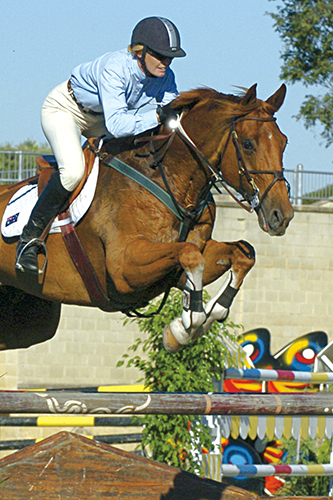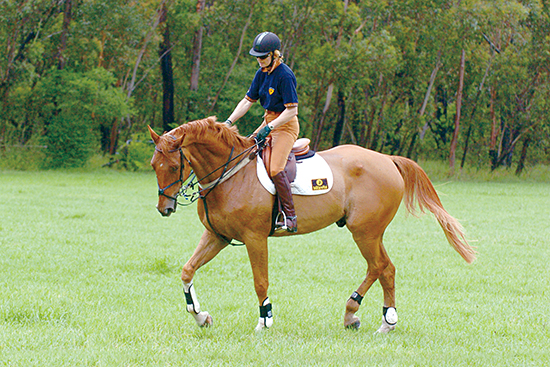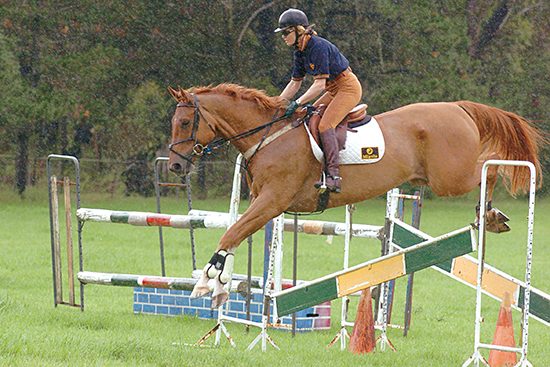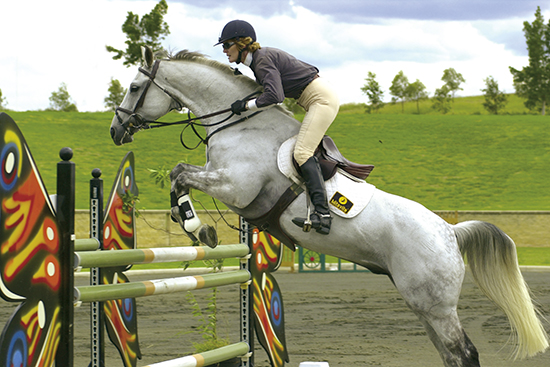Two totally different strategies for two totally different horses…
Story by Chris Hector & photos by Roz Neave
Vicki Roycroft met up with her new showjumping star, Infatuation, thanks to that wonderful European dealer’s policy of ‘if the horse doesn’t work out, we take it back’.
“Early last year I was phoned by the guys in France – Edouard Couperie and Eric Negre, who I’ve bought a number of horses from – I bought Errol (Premier des Hayettes) from them, bought Visage from them, bought Ricardo from them, and I’ve known them since 1987. I’ve spent a fair bit of time at their place, ridden their horses, that sort of thing. We’re good friends and we’ve done business over a long period of time, they rang and said, we’ve got this wonderful horse for you. He won’t be expensive, he’s difficult – he’ll suit you very well. And he’s a very good jumper.”
“When I went over to Athens, between the UK camp and the Games, I went to France, tried the horse over two days.”
Was it wild?
“Oh yes, pretty wild. They didn’t give me any illusions about him. They said, he is a really hot, difficult horse, but we think he will suit you.”
And he had already been sacked in the States?
“He was bought by the French guys for American clients in 2003, spent three months in the States but didn’t show and was sent back, because European dealers do that. When he was sold he was jumping at Grand Prix level. Their stable rider then as well as Edouard Couperie, was Edouard Mathé who is now riding for Zangersheide. I say a video of the horse jumping at Luhmulen with Mathe, and he really looked very good – but then there was no one left to ride the horse, so that is when they rang me.”
“I bought him, but the French kept a share in him.”
What did you like about him?
“Obviously his scope. I don’t think I’ve sat on a scopier horse. Luna and Coalminer were exceptionally scopey but this guy has more scope than either of them. Once I’d been in Athens I was very grateful for the positive decision I had made. In the past I have thought I don’t need that much scope. I did the WEG in 1990 on Mickey Mouse, who actually wasn’t the scopiest horse in the world, but he had a good mind and we had a good partnership. I always felt I could live without scope as long as I’ve got the carefulness. I thought maybe this horse had too much scope, but when I got to Athens, they were seriously seriously big tracks.”
“The sport keeps evolving. The first qualifier I thought was really big, but the riders said, no, tough but fair. The whole Olympics was a supreme test, you just had to have an extraordinarily good horse to cope with it. In the end that justified my decision, because I think this horse will jump those courses easily. I don’t think there are too many horses in Australia that could do an Olympics or World Games, and Aachen will be humungous – no doubt about that.”
What didn’t you like about him?
“He’s big and he is hot. Normally I like small horses – he’s 17.3, but he is like Luna was, he is a big well-balanced horse to sit on, when he is being soft. When he is being hot he tends to throw you around a bit. I love the challenge. I enjoy working with a horse like this because it is certainly not boring.”
Did you expect to win your first World Cup qualifier?
“No! When I first went to grade the horse, I thought he might go into B grade because I honestly didn’t know what he would be like in the ring. He hadn’t shown for well over six months, there were obviously enough problems that didn’t show in the States, but in the end I thought, what the heck, A grade him. Canberra was the first show, but unfortunately the standard at the moment isn’t great, so I knew it would be a 1.40 / 1.45 track, and with all that scope, it would not be difficult for him.”
“He had a start on the first day with one down and actually felt better in the ring than he can when you are training him. I find the horse settles better when I start to jump him. Whereas with a lot of hot horses it is the reverse – but he gets softer and more comfortable when he is jumping. The next day he was very good, there were only two double clear rounds, he was a bit clagged by the third round, he had only been out of quarantine four weeks! But he still did enough to win, which amazed everyone. I was amazed!!”
How do you work a horse like that – he has a huge amount of scope, but you are worried that he might not be so careful?
“I think he is a horse that is careful enough when he is focussed up. The way I ride horses, because I like to make it as easy as possible for them, they can get lackadaisical – I found that with Luna and Coalminer, who were enormously scopey but they just got a bit switched off, because it was easy for them. That’s the problem I worry about with this horse, but mind you, he makes everything so difficult for himself that he keeps himself careful. I don’t mind that bit of hotness as long as he focuses up because he is actually making life tough, that helps him think about keeping his legs out of the way. I feel that if I get him really dozy and rideable, he might not be so careful.”
You can’t school him to put in the extra stride?
“As well as the huge jump, he’s got a huge stride. His big problem at the moment is combinations, there are combinations that I could easily cut the stride out and in lines I often let him leave a stride out as opposed to adding. That was one of biggest things I learnt when I was in Europe with Apache, and training with Paul Schockemöhle. Paul could only think of German horses, you have to make them add, you have to teach them – but with that little Australian Thoroughbred, it would have sent him crazy. I could rely on him on course where I absolutely had to add a stride, I could do it. But if I tried to make him do it, he’d just go nuts. It didn’t suit the Thoroughbred brain as opposed to the Warmblood brain. This guy is the same, if you try to bottle him up; he gets more and more steamy. It is better if he is allowed to float where he can and then when he has to add the stride he is more amenable to doing it.”
Is most of your work with a horse like Irish, on the flat, suppling?
“With this guy, yes. With any hot horse it is the same. With hot horses, you are always trying to slow the reactions down, the cold horse you are trying to sharpen up. With the cold horse you do a whole bunch of different things to keep them thinking and alert, with the hot horse, you are always trying to keep it boring and repetitious so that they understand. The trouble is that their brain goes quicker than their legs and they can get so easily steamed up and upset. Whereas if you can keep things simple, work in a logical fashion, simple – forward, back, one side, the other side, that’s basically all you want. That they have brakes and they turn left and right. That’s all the work I do with this guy.”
What sort of suppling work?
“He’s got a real left shoulder bulge. When he gets stressed, all he wants to do is push his left shoulder out and tank off – so a lot of the work is moving him away from the left leg, and keeping his left shoulder open. I’m always working on keeping him straight and listening to my aids.”
“I found early in the piece that when I wanted to settle him, and there were times when I found it hard to justify buying this horse because he was quite loopy, so a couple of times I said, bugger it, I’m going to jump him – there must have been a reason why I bought him. The funny thing I found when I jumped him, the horse suddenly settled and became more calm. It gave him something to focus up on.”
“Now I don’t find I need to do that, because I don’t want to jump him a lot, but in those early days, I found that it was something to make me feel good about the horse because otherwise it could become so frustrating. In anything like that you have to be patient and I think it is well known that I am not the world’s most patient – or tolerant – person. This is where riding is good, it teaches you those things, and especially this horse, I just had to be patient with him. Those first few times when I was thinking ‘why did I buy this horse?’ I’d just go jump him and he really is a Rolls Royce.”
Irish is a very different personality from the grey horse, Ricardo?
“That’s a bit of the opposite end of the scale. Ricky came through the same guys in the same way. He wasn’t such a super expensive horse because he was difficult. The Europeans thought he was limited, but he was more that nature of horse that I like, I don’t know if he has all the scope in the world. I think in his nature he is like Mickey Mouse in that he thinks he’s got all the scope in the world. He’s a feisty little horse, and again he was sold to the States, spent 12 month there and came back – he’s one of those horses that will half try and jack up in places and be naughty, but he actually hasn’t got a bad bone in his body, he’s just a smart switched on little horse, that you need to teach to work with you. I find him wonderful because once he is working with you, he is super – technically fantastic.”
“He’s had problems. He had three months off last year because he was kicked in the shoulder, he came back, and then at Melbourne Show he won the World Cup and the Grand Prix. The World Cup was in spooky circumstances but he jumped fabulously, and then two days later jumped a much bigger track in the Grand Prix. That’s where I decided I had a very good horse.”
“He’s different from Irish because he’s easy, in fact you have to push him around so he knows you are the boss.”
 What does a working session with him look like?
What does a working session with him look like?
“With Ricky we do a lot more different work. A lot of lateral work, changes, lots of transitions. He wants to be a little plank, I think that’s what he learnt in the States, to go like a plank, and I have to work on him to keep him round – whereas Irish when he is relaxed is naturally round and soft. Ricky had got out of working that way so now you have to make him work and push him round. With any horse it is a partnership, but the attitude you are looking for is ‘What do you want me to do now?’ Ricky was inclined to say, piss off I’m doing my own thing with his previous riders. But now he respects me, and we get along really well. He’s a lovely horse and does everything I want, very willingly.”
So how did you manage that transformation when the Americans couldn’t and they are generally well-educated, thoughtful riders?
“Here in this country we are so lucky because most of our riders have to learn how to work with a horse’s mind, because we ride Thoroughbreds – and hey, I’ve probably been doing it thirty years longer than most other people! That’s where experience helps, and working with so many different horses. That’s why I had a lot of fun in Europe, working at François Mathé’s, because they put me on all these horses they say are difficult – and they are not difficult like our Thoroughbreds.”
“I was lucky because my transformation was working with Bill and Wayne Roycroft, and George Morris to refine my riding, from being just a hot Thoroughbred rider to how to actually push a horse through and use your aids, how to ride properly, that took me from being just an instinctive rider of difficult horses to knowing how to educate the horse, and be an educated rider.”
First published in THM April 2005.



